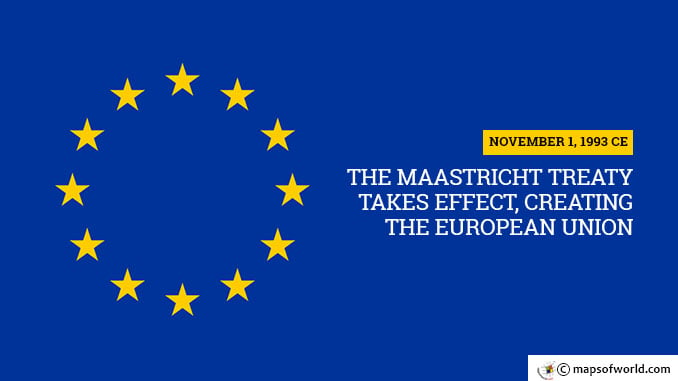After months of negotiations and a long ratification process, the Maastricht Treaty came into force on November 1, 1993. The European Union (EU), featuring a central bank and deeper military alliances, created closer ties than had ever existed before, organizing previous entities under one umbrella in a far more streamlined fashion. The roots of the EU date to the period after World War II. Two major conflicts within just 20 years of each other, fueled in large part by nationalist fervor, had left some leaders wondering if emphasizing the ties that bound the continent together might be a better strategy for preventing hostilities in the future. The European Coal and Steel Community, a group of six nations including major industrial powers like France, West Germany and Italy, united in 1950 to pool manufacturing resources as a “supranational” confederation. Robert Schuman, the Foreign Minister of France at the time, hoped to “make war not only unthinkable but materially impossible” — the close economic ties would force them to rely on each other so much, no country would think of attacking another. Over time, the nations became more intimately interwoven, and were soon looked on as a common European Community with extensive economic connections and shared concerns for the responsible development of nuclear energy. By the mid-1970s, the group included the United Kingdom, Ireland and Denmark. Before long, many nations opened borders between neighboring countries. The possibility of a true EU seemed to shift from merely an option towards being an inevitability. With the collapse of the Soviet Union in the early 1990s — and particularly the fall of the Berlin Wall in 1989 — a discussion about formalizing the process for a country to gain membership heated up. In February 1992, representatives from the European Community announced a historic agreement: the Maastricht Treaty would establish a new EU with specific guidelines and a common currency. In many countries, however, the battle to convince a skeptical public was just beginning. Six months after the announcement in the Netherlands, France narrowly ratified the treaty. The citizens of Denmark rejected the agreement outright, forcing the members to gather in Edinburgh, Scotland to make amendments during a meeting in December 1992. Once the four points of contention were answered for the Danish, a second referendum the following June sealed the deal: all member nations had ratified the agreement, making the European Union an official body beginning on November 1, 1993. Residents of the 12 nations signing the Maastricht Treaty — Germany, France, Italy, the Netherlands, Belgium, Luxembourg, Denmark, Ireland, the United Kingdom, Greece, Spain and Portugal — were able to move themselves and their goods throughout much of the continent with little restriction. In the coming years, membership expanded to include another 16 countries, bringing the total number of participants to 28 when Croatia is officially instated in July 2013. Despite severe economic instability in the wake of worldwide financial turmoil in 2008, the EU seems to be making every effort to weather the current debt storm in the hopes of a brighter future. Also On This Day: 1512 – Michaelangelo’s work on the ceiling of the Sistine Chapel is revealed to the public 1755 – An earthquake and tsunami in Lisbon, Portugal kill at least 60,000 1800 – United States President John Adams moves into the newly-opened Executive Mansion — the White House 1922 – The last sultan of the Ottoman Empire, Mehmed IV, steps down from the throne 1963 – The world’s largest radio telescope, the Arecibo Observatory, opens in Arecibo, Puerto Rico
November 1 1993 CE – The Maastricht Treaty Takes Effect, Creating the European Union
After months of negotiations and a long ratification process, the Maastricht Treaty came into force on November 1, 1993. The European Union (EU), featuring a central bank and deeper military…
